等级资料秩和检验方法步骤
- 格式:pdf
- 大小:1016.58 KB
- 文档页数:4

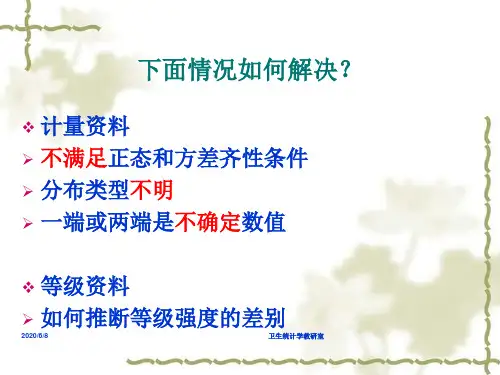
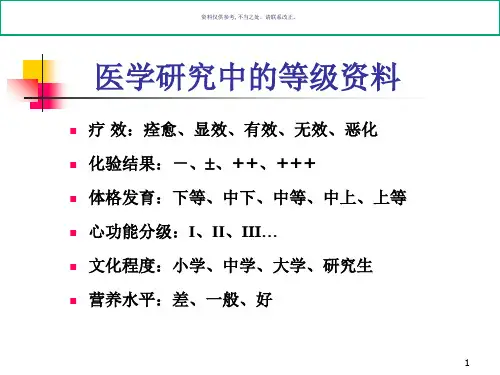
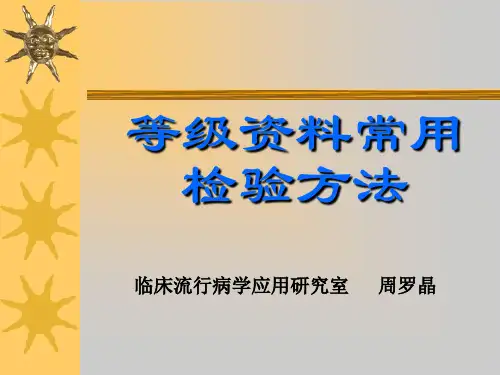

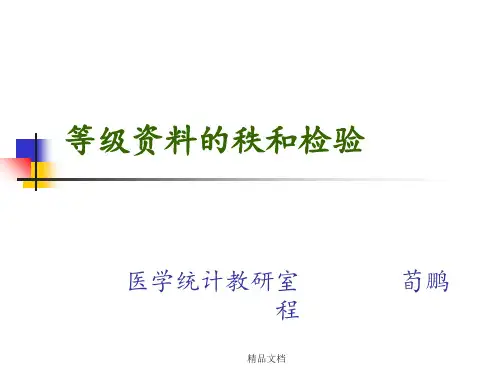
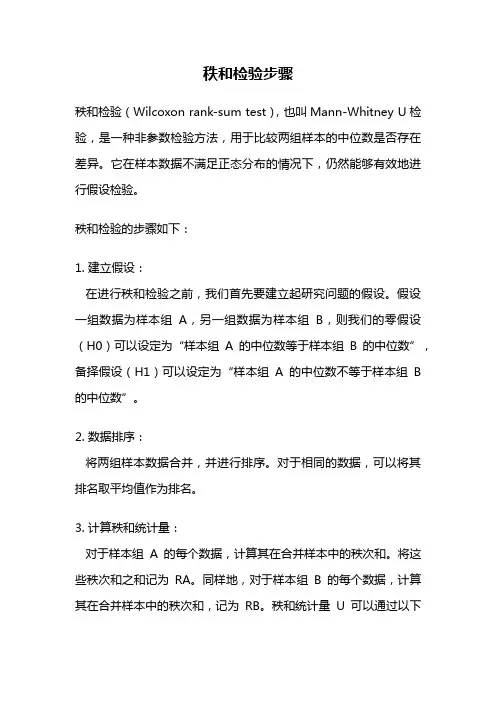
秩和检验步骤秩和检验(Wilcoxon rank-sum test),也叫Mann-Whitney U检验,是一种非参数检验方法,用于比较两组样本的中位数是否存在差异。
它在样本数据不满足正态分布的情况下,仍然能够有效地进行假设检验。
秩和检验的步骤如下:1. 建立假设:在进行秩和检验之前,我们首先要建立起研究问题的假设。
假设一组数据为样本组A,另一组数据为样本组B,则我们的零假设(H0)可以设定为“样本组A的中位数等于样本组B的中位数”,备择假设(H1)可以设定为“样本组A的中位数不等于样本组B 的中位数”。
2. 数据排序:将两组样本数据合并,并进行排序。
对于相同的数据,可以将其排名取平均值作为排名。
3. 计算秩和统计量:对于样本组A的每个数据,计算其在合并样本中的秩次和。
将这些秩次和之和记为RA。
同样地,对于样本组B的每个数据,计算其在合并样本中的秩次和,记为RB。
秩和统计量U可以通过以下公式计算:U = min(RA, RB)4. 计算临界值:在给定显著性水平下,查找秩和统计量U对应的临界值。
可以使用查找表或计算机软件进行计算。
5. 做出决策:将计算得到的秩和统计量U与临界值进行比较,如果U小于临界值,则拒绝零假设,认为样本组A的中位数与样本组B的中位数存在显著差异;反之,如果U大于临界值,则接受零假设,认为两组样本中位数没有显著差异。
秩和检验的优点是不依赖于数据的分布情况,对于小样本量和非正态分布的数据也适用。
此外,秩和检验还可以应用于有序分类数据或等级数据的比较。
需要注意的是,秩和检验对于两组样本的样本量应该相等或接近,否则可能会影响检验结果的可靠性。
此外,如果样本量较小,可能会导致统计功效不足,即无法准确地检测到中位数的差异。
在实际应用中,秩和检验常用于医学研究、生物学研究以及社会科学等领域。
通过比较不同组别的样本中位数,可以发现变量之间的差异或者评估某个处理对样本的影响。
秩和检验是一种重要的非参数检验方法,能够在数据不满足正态分布的情况下进行假设检验。

非参数统计中的秩和检验方法详解统计学是一门研究数据收集、分析、解释和展示的学科,它在各个领域都有着广泛的应用。
而在统计学中,参数统计和非参数统计是两种常见的方法。
参数统计是根据总体的参数进行推断,而非参数统计则是不对总体参数做出假设的一种统计方法。
在非参数统计中,秩和检验方法是一种常用且重要的方法。
本文将详细介绍非参数统计中的秩和检验方法。
一、秩和检验简介秩和检验是一种基于秩次的非参数检验方法,它主要用于对两个独立样本或多个相关样本的总体分布进行比较。
这种方法的优势在于对数据的分布形状没有要求,适用于各种类型的数据。
在进行秩和检验时,首先需要将样本数据进行排序,然后根据排序后的秩次进行计算。
接下来,通过比较秩和的大小来进行假设检验,从而得出结论。
二、秩和检验的应用场景秩和检验方法可以应用于诸多实际场景中。
比如,在医学研究中,可以用秩和检验方法来比较两种不同治疗方法的疗效;在工程领域,可以用秩和检验方法来比较不同生产工艺的产品质量;在市场营销中,可以用秩和检验方法来比较不同促销策略的效果等等。
总之,秩和检验方法在实际问题的解决中有着广泛的应用。
三、秩和检验的类型秩和检验包括了许多不同类型,其中最常见的包括Mann-Whitney U检验、Wilcoxon秩和检验和Kruskal-Wallis H检验。
下面将分别对这些检验进行详细介绍。
1. Mann-Whitney U检验Mann-Whitney U检验是一种用于比较两个独立样本的非参数检验方法。
它基于两组数据的秩次进行比较,通过计算秩和来判断两组数据是否来自同一总体分布。
Mann-Whitney U检验的原假设是两组样本来自同一总体分布,备择假设是两组样本来自不同总体分布。
通过计算U统计量和p值来进行假设检验,从而得出结论。
2. Wilcoxon秩和检验Wilcoxon秩和检验是一种用于比较两个相关样本的非参数检验方法。
它与Mann-Whitney U检验类似,同样是基于秩次进行比较。

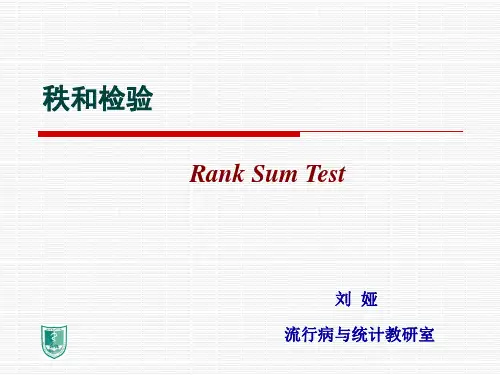
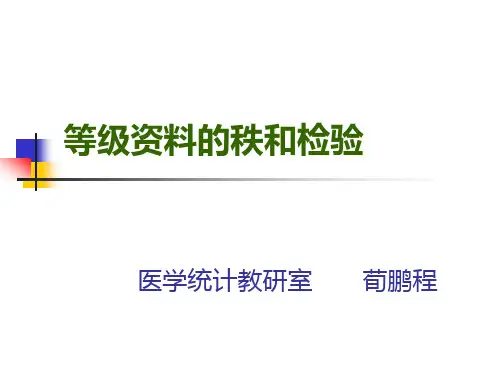
等级资料的秩和检验步骤The rank sum test, also known as the Mann-Whitney U test, is a nonparametric test used to determine if there is a significant difference between the medians of two independent groups. This test is often used when the datais not normally distributed or when the assumption of homogeneity of variance is violated. The rank sum test is particularly useful when working with ordinal or interval data, as it does not rely on the assumption of normality.The first step in conducting a rank sum test is to rank all the data from both groups combined, from lowest to highest. Ties are handled by giving each tied value the average of the ranks they would have received if they were not tied. Once the data is ranked, the sum of the ranks for each group is calculated. The test statistic is then calculated as the smaller of the two rank sums. This test statistic is then compared to a critical value from the Mann-Whitney U distribution to determine if the difference between the groups is statistically significant.One of the key assumptions of the rank sum test is that the two groups being compared are independent of each other. This means that the data in one group should not be influenced by the data in the other group. If this assumption is violated, the results of the rank sum test may not be valid. It is important to carefully consider the design of the study and the nature of the data before choosing to use the rank sum test.Another important consideration when conducting a rank sum test is the sample size. While the rank sum test is robust to violations of normality and homogeneity of variance, it is less powerful than parametric tests whenthe sample size is small. As a general rule of thumb, the rank sum test is most appropriate when the sample size is greater than 20 in each group. When the sample size is small, it may be more appropriate to use a parametric testif the assumptions of the test can be met.In addition to the rank sum test, there are other nonparametric tests that can be used to compare twoindependent groups, such as the Wilcoxon signed-rank test and the Kruskal-Wallis test. The choice of test should be based on the nature of the data and the specific research question being addressed. It is important to carefully consider the assumptions and limitations of each test before making a decision.In conclusion, the rank sum test is a valuable tool for comparing the medians of two independent groups when the data is not normally distributed or when the assumption of homogeneity of variance is violated. By carefully considering the assumptions and limitations of the test, researchers can make informed decisions about the appropriate statistical analysis for their data. The rank sum test provides a robust and flexible approach to comparing groups, and can be particularly useful when working with ordinal or interval data.。